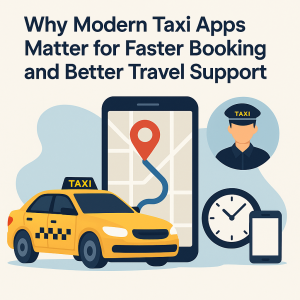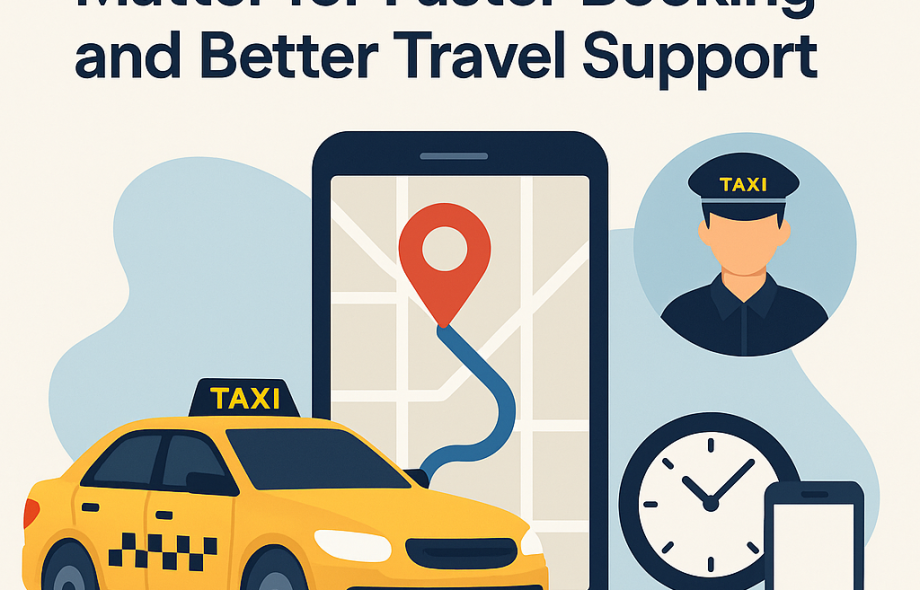The evolution of transportation in urban spaces has been heavily shaped by digital platforms designed to simplify the way people move from one location to another. Among these platforms, modern taxi applications have become essential tools, allowing users to book rides instantly and access reliable travel support with minimal effort. These platforms are built to match riders with drivers efficiently, reduce waiting times, and offer transparent trip information. They address long-standing issues associated with traditional taxi services by introducing systems that prioritize speed, accuracy, and user convenience. Businesses and startups also increasingly explore solutions such as a white label Taxi App to rapidly enter the market with ready-to-deploy technology. This shift demonstrates how deeply integrated mobile technology has become in shaping mobility experiences worldwide.
Modern taxi platforms are more than ride-booking applications. They serve as complete ecosystems that combine navigation, analytics, payment processing, and communication modules. These tools create a more controlled and predictable environment for both passengers and drivers. As the demand for fast, reliable, and accessible transportation continues to rise, modern taxi apps play a pivotal role in fueling a more connected and efficient mobility landscape.
Key Digital Shifts Driving Smarter and Faster Transportation Systems
Transportation systems have undergone rapid digital progress over the past decade, with mobile-first solutions acting as the primary driver of innovation. The shift from manual dispatching to automated ride matching is a fundamental change that has drastically reduced service delays. With cloud infrastructure and intelligent routing engines, ride requests can be processed within seconds. The widespread availability of smartphones further accelerates this transformation, enabling large populations to access these services with ease.
Several digital shifts contribute significantly to the enhanced speed and support offered by these applications.
- The integration of real-time GPS tracking helps reduce ambiguity and enhances trust between the rider and driver.
- Data analytics improves the precision of demand forecasting, helping ensure that fleets are optimally distributed across zones.
- Automated fare estimation allows users to understand costs before the ride begins, reducing uncertainty and improving transparency.
These shifts ensure that transportation ecosystems can scale without compromising user experience. They also help streamline operations, making it easier for companies to support higher ride volumes without sacrificing efficiency.
Essential User Expectations Shaping Today’s App-Based Ride Services
User expectations have evolved considerably due to the convenience offered by modern digital platforms. People now expect transportation systems to function with accuracy, responsiveness, and minimal friction. The success of contemporary taxi applications largely depends on their ability to meet these expectations while maintaining consistent performance.
Key expectations influencing app design and functionality include:
- Instant booking without long wait times or unpredictable availability.
- Transparent information, including driver details, vehicle type, and estimated arrival time.
- Secure and flexible payment methods allowing users to choose between cashless and traditional options.
- Reliable customer support, ensuring prompt resolution of trip-related issues.
- Accurate navigation, backed by updated mapping technologies.
Meeting these expectations requires continuous improvement in platform architecture, interface usability, and backend performance. User satisfaction remains the central measure of success for any modern ride service, making it essential for businesses to understand the evolving needs of passengers and drivers alike.
Core Features That Enhance Booking Efficiency in Modern Taxi Apps
Ride-booking speed and reliability depend significantly on the features that power modern taxi platforms. The most important features work collectively to reduce manual intervention, automate decision-making, and improve communication across the trip lifecycle. While companies may customize their applications, several critical features consistently shape successful platforms.
These features include:
- Intelligent ride matching that pairs riders with the closest available drivers.
- Real-time location sharing to improve safety and transparency.
- In-app communication tools, allowing users and drivers to connect seamlessly.
- Route optimization algorithms that minimize travel time and fuel consumption.
- Dynamic pricing models that adjust fares during peak demand for better fleet utilization.
The inclusion of these capabilities makes platforms more dependable and user-friendly. They allow riders to book with confidence while enabling drivers to manage their schedules more efficiently. Businesses exploring industry-ready solutions, such as white label app solutions, often rely on feature-rich templates that incorporate these essential functions from the start.
Operational Advantages Delivering Reliable Travel Support for Users
In addition to rapid booking, modern taxi applications offer operational advantages that strengthen the overall travel experience. Reliability is a major factor shaping whether users continue to depend on a mobility platform for daily transportation. By using technology to eliminate common inefficiencies, ride-booking apps create more predictable services that better support commuters.
Key operational advantages include improved safety protocols, efficient fare processing, and a more organized system for tracking trips. The digital record of each journey allows both riders and service providers to verify details easily, which reinforces trust. Drivers benefit from structured workflows and access to consistent navigation guidance, reducing stress and improving service quality.
For companies, these operational improvements translate into better fleet coordination, lower response times, and enhanced resource management. Seamless communication between users and service providers ensures issues are resolved quickly, contributing to a stronger perception of reliability.
Scalability Factors Influencing Growth for App-Based Ride Platforms
Modern taxi apps must be capable of scaling in response to growing urban populations and expanding service areas. Scalability ensures that platforms maintain speed and reliability even when ride demand increases significantly. Many businesses choose a model such as the white label Taxi App because it supports flexible growth without requiring development from scratch.
Several factors influence the scalability of ride-booking platforms:
- Modular system architecture, enabling new features to be added without disrupting existing ones.
- Optimized databases, ensuring that trip data, driver availability, and user activity can be processed rapidly.
- Cloud computing resources, allowing platforms to adjust storage and processing power based on usage patterns.
- Automated fleet management tools, which help operators allocate vehicles efficiently.
Platforms that prioritize scalability can enter new geographic markets more smoothly and support higher ride volumes while maintaining consistent performance. This makes them suitable for both local taxi operators and larger mobility enterprises planning regional or national expansion.
Technical Priorities Behind Building High-Performance Mobile Solutions
Behind every efficient ride-booking experience is a robust technical foundation. High-performance taxi platforms require carefully designed backend systems that support fast transactions, secure data exchange, and uninterrupted service operations. Technical priorities often begin with deciding on the best frameworks, APIs, and server environments. These choices determine how reliable the app will be under varying traffic conditions.
Key technical priorities include:
- Strong data encryption, protecting personal information and payment details.
- Optimized server response times, ensuring instant ride confirmations.
- Integration of advanced mapping APIs, enabling accurate navigation.
- Automated testing routines, helping identify issues before deployment.
The success of any taxi app development initiative depends on balancing these technical needs with user-focused design principles. Developers must ensure every feature operates smoothly, especially during peak usage hours. They also need to maintain an update cycle that keeps the application aligned with new device standards and system requirements.
Future Trends Expected to Reshape Urban Mobility and App Innovation
The future of mobility will be shaped by emerging technologies that enhance how people plan and complete their journeys. With cities becoming more connected and transportation networks more diverse, taxi applications will continue to evolve. Upcoming innovations aim to refine the precision, convenience, and adaptability of mobility platforms.
Prominent future trends include:
- Integration of autonomous vehicles for safer and more efficient transportation.
- Enhanced artificial intelligence, improving demand forecasting and route selection.
- Voice-controlled interfaces, enabling hands-free interactions.
- Eco-friendly mobility options, supporting sustainability efforts in urban environments.
As these trends mature, the cost to build taxi app systems may vary depending on the complexity of the technology stack and the degree of customization required. However, the long-term benefits of adopting these improvements include smoother operations, better resource management, and more sustainable urban transport models.
Challenges Slowing Adoption and the Need for Stronger App Strategy
Despite the progress made in the mobility industry, certain challenges still slow the adoption of modern ride-booking apps. These challenges include infrastructure limitations, inconsistent driver availability, and regulatory barriers. In some regions, mobile networks or mapping tools may not be fully optimized, which can affect navigation accuracy or service reliability.
Businesses also face challenges in maintaining balanced rider-driver ratios, especially during peak hours. Achieving this balance requires strong operational strategies and continuous monitoring of demand patterns. Additionally, maintaining data security and user privacy remains a significant responsibility. Companies must ensure they follow stringent security practices to protect sensitive information stored within the platform.
Addressing these challenges requires strategic planning, investment in technology enhancements, and a deep understanding of user needs. Businesses that focus on platform stability, operational efficiency, and long-term innovation can better overcome these barriers and deliver services that consistently meet user expectations.
Conclusion
Modern taxi applications have transformed how people access transportation services by improving booking speed, operational efficiency, and overall dependability. Their continued evolution contributes to a more streamlined and responsive mobility ecosystem. As technology advances and user expectations rise, these platforms will remain central to shaping the future of urban travel, offering new opportunities for improved accessibility and innovation.

white label Taxi App
 :
https://www.pinterest.com/patriciasmithusa/
:
https://www.pinterest.com/patriciasmithusa/












